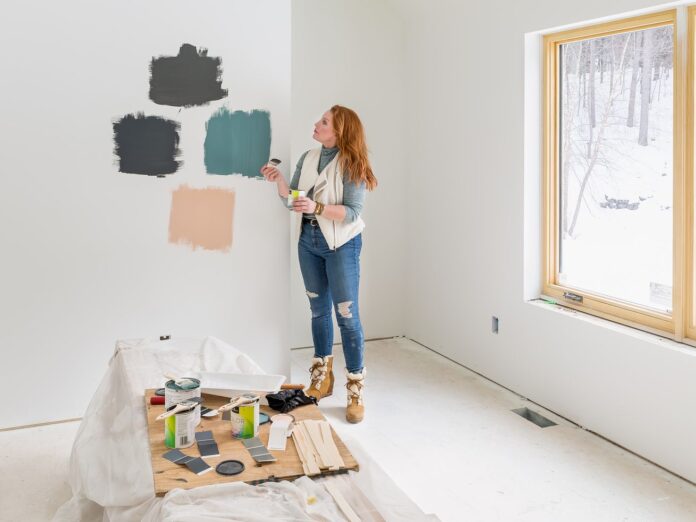[ad_1]

Are you looking for a safer alternative to traditional interior paints? Read this guide to learn how to choose the right type of products for painting projects that will yield great results with a less negative impact on the planet and your family’s health. Here’s what you need to know about buying non-toxic paint safe for you and the environment.
There’s a whole spectrum of paint options, from colors and brands to finishes and formulas. And while picking the just-right shade for your living room or furniture rehab project may be the main thing on your mind, it may also be just as important to consider what the paint is made of. After all, it may contain VOCs—harsh chemicals that could harm your family’s health and the planet.
The Components of Paint
At its most basic, paint consists of pigments for color and binders (a.k.a. resins) to provide adhesion, in a liquid base (a.k.a. solvent) for application onto surfaces. Latex and acrylic paints are water-based, while oil-based paint often relies on synthetic solvent. Rule of thumb for the eco-conscious: Water-based paints, like latex and acrylic, are safer than oil-based formulas.
Paint can also include all manner of additives to make it go on more smoothly, dry faster, last longer, resist stains and scuffs, or enhance some other quality. In terms of eco-safety, generally the fewer additives, the better. Several to watch out for: pesticides (often found in “antifungal” paints), biocides (a common preservative), and metals used in pigments (such as cadmium and chromium).
What Makes for an Eco-Friendly Paint?
Most people nowadays have at least heard the buzzword VOCs. It stands for volatile organic compounds, which are the chemicals most commonly found in a variety of commercial products and used in the stabilizers, driers, thickeners, and preservatives in paints.
How do VOCs Work?
VOCs are released into the air as gases and have a strong, noxious odor—and their concentrations are up to 10 times higher indoors than outdoors. Unfortunately, their toxicity can remain long after the smell dissipates.
According to the Environmental Protection Agency, short- and long-term adverse health effects associated with VOCs run the gamut from allergic reactions, headaches, and nausea to the liver, kidney, and central nervous system disorders and even cancer. Some VOCs are also known to damage the ozone layer. The EPA currently limits the amount of VOCs in “low-VOC” latex paints to no more than 250 grams per liter (gm/l) and no more than 380 gm/l for “low-VOC” oil-based paints.
Better still for the green-conscious are the “zero-VOC” paint products now on the market. Some commercial paints labeled as such can contain no more than 5gm/l VOCs, whereas simpler formulas such as chalk paint and milk paint (more on them below) may be entirely VOC-free. While it’s always a good idea to ventilate the area where you’re painting, an upside of low- and zero-VOC paints is that there’s not an overwhelming smell during application.
Look for Certified Seals
Paint companies don’t often print a detailed ingredients list on their labels, which makes identifying what’s in the can a challenge. Even reviewing the technical data sheet online may not provide full disclosure.
So how can you be sure you are buying eco-friendly paint? Check for independent testing certification seals. Paints that bear the GREENGUARD label, for instance, will have less than 50 grams of VOCs per liter, while those that have earned the Green Seal cannot exceed 50 grams of VOC per liter for flat paint and 100 grams per liter for non-flat paints. (The EPA maintains a list of private-sector standards and eco-labels for interior latex paints here.)
The GreenWise seal also indicates that the products have been tested and certified by Coatings Research Group Inc.; however, since this is an association of paint manufacturers, it has less credibility than independent organizations.
Consider Natural Paints
DIYers with green goals should know there’s a difference between low- or even no-VOC paints from large commercial brands and the separate category of “natural” paints, namely chalk paint, clay paint, and milk paint. The latter will usually be made in smaller batches, contain fewer and simpler ingredients—and cost more. Undoubtedly, budget-minded folks often choose paints of this ilk for such projects as adding a fresh new coat to old furniture pieces rather than paint an entire room.
Keep in mind that “natural” has a fairly loose definition in the realm of paint products (for our purposes, we categorize chalk, clay, and milk paints as natural paints). Some natural paints may include terpenes, which are VOCs derived from plants for instance. And while casein—a protein used as a binder in milk paint—is a “natural” animal product, it may not be considered wholly environmentally sound since large-scale dairy facilities have been found to contribute to the emission of greenhouse gases.
The Best Eco-Friendly Paints
When major paint manufacturers first started developing more health- and eco-conscious products, the early formulas had flawed results, but there have been significant improvements over the past decade.
Many of today’s low- and zero-VOC paints, including natural paints, provide excellent coverage, beautiful colors, easy application, and even finishes. However, for longevity on exteriors and high-traffic surfaces like floors, some consumers may still opt for paints with ingredients such as biocides that stand up to heavy wear-and-tear conditions. (That said, bear in mind that a quality latex paint with a high percentage of pigment plus binder solids—particularly binders that consist of 100 percent acrylic polymers—can extend the product’s durability.)
Those looking for eco-friendly paints should ideally seek products that, in addition to having few VOCs, utilize natural pigments and are low in biocides (active chemical molecules to control the growth of or kill bacteria, usually present in exterior paint).
Visit Green America for links to paint companies vetted by this non-profit membership organization that promotes environmentally aware, ethical consumerism. Also, consider the following brands and products:
- AFM Safecoat: This zero-VOC, fast-curing interior paint is easy to use and cleans up with soap and water.
- Backdrop: Known for their trendy colors in a limited palette, this brand offers low-VOC latex paints that are GreenWise certified, as well as 12 x 12 inch stickers instead of the traditional swatch/sample selection process.
- Behr Premium Plus: The great thing about this zero-VOC interior paint is that it doesn’t require primer yet still provides amazing hiding and coverage, plus it is stain- and scrub-resistant.
- BioShield: This zero-VOC, solvent-free wall paint applies easily over any standard gypsum board, sheetrock, plaster, or masonries such as concrete and brick.
- ECOS Paints: You’ll get a zero-VOC paint with good hiding, coverage, adhesion, and mildew resistance. Even the shipping is more eco-friendly thanks to 100-percent post-consumer recycled containers and boxes.
- EcoSelect Zero VOC Interior Latex Paint: Sherwin-Williams’ zero-VOCs product boasts good spatter resistance, and it’s suitable for use on walls and ceilings of wallboard, primed plaster, wood, and masonry.
- Old Fashioned Milk Paint: Made in small batches, this zero-VOC milk paint contains earth pigments in beautiful, rich colors.
- Ultra Spec 500: This zero-VOC interior paint from Benjamin Moore offers great hiding, easy application, and soap-and-water cleanup.
- Unearthed Paints: To give it even more eco-friendly cred, this zero-VOC milk paint uses vegetable-based casein for a dairy-free approach.
[ad_2]
www.thisoldhouse.com










